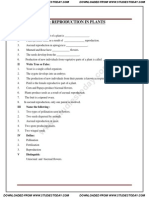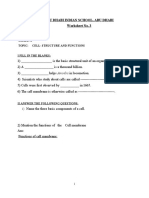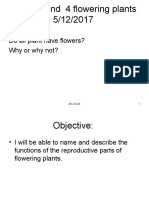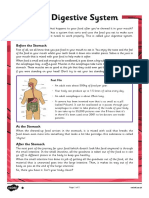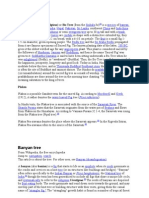Pollination and Fertilisation
Pollination and Fertilisation
Uploaded by
mihayedoCopyright:
Available Formats
Pollination and Fertilisation
Pollination and Fertilisation
Uploaded by
mihayedoOriginal Description:
Copyright
Available Formats
Share this document
Did you find this document useful?
Is this content inappropriate?
Copyright:
Available Formats
Pollination and Fertilisation
Pollination and Fertilisation
Uploaded by
mihayedoCopyright:
Available Formats
Plant reproduction pollination and fertilisation
Teaching notes
This could be used as a review worksheet or as part of a teacher guided lesson through
plant pollination and fertilisation.
As an extension or homework task you may ask the students to complete a storyboard
activity showing the process of pollination/fertilisation or both.
Answers
Task 1
Name of reproductive
part
filament
Function
Holds the anther up
ovule
The egg cell. This will become the seed when it has been fertilised.
sepals
Small leaves under the flower, which protected the flower bud.
anther
Produces the male reproductive cells, pollen.
ovary
Contain the female reproductive cells or ovules.
style
The structure between the ovary and the stigma.
petals
Attract insects to the flower.
stigma
The place where pollen lands for pollination to occur.
www.teachitscience.co.uk 2014
22739
Page 1 of 5
Plant reproduction pollination and fertilisation
Task 2
Pollen carried by
Adaptation
the wind
very low mass
insects
higher mass
sticky, spikey surface
smooth surface
rich in protein
may have air sacs
produced in very large quantities
produced in smaller quantities
Self pollination: Pollen is carried from the anther of a plant to the stigma of the same
plant.
Cross pollination: Pollen is carried from the anther of a plant to the stigma of another
plant.
Task 3
Pollen is deposited onto the stigma, this is called pollination.
A pollen tube starts to grow down the style.
The pollen tube continues to grow down towards the ovary.
When the pollen tube reaches the ovary, the nucleus of the male sex cell travels down the tube.
The pollen nucleus fuses with the ovule nuclei and fertilisation is complete.
The fertilised ovule divides and develops into an embryo.
The embryo develops into a seed. The ovary swells and ripens into a fruit.
www.teachitscience.co.uk 2014
22739
Page 2 of 5
Plant reproduction pollination and fertilisation
The reproductive organs of a plant are the flowers. They contain male and female
parts.
Task 1
a) Use the names of the plant reproductive parts in the box below to label the
diagram of the flower.
stigma
ovule
ovary
sepal
petals
anther
filament
style
b) Circle the 3 female reproductive parts in pink and circle the 2 male reproductive
parts in blue.
c) Match the parts of the flower to their function to complete the table below:
Name of
reproductive part
Function
Holds the anther up.
The egg cell. This will become the seed when it has been fertilised.
Small leaves under the flower, which protected the flower bud.
Produces the male reproductive cells, pollen.
Contains the female reproductive cells.
A structure between the ovary and the stigma.
Attract insects to the flower.
The place where pollen lands for pollination to occur.
www.teachitscience.co.uk 2014
22739
Page 3 of 5
Plant reproduction pollination and fertilisation
Pollination is when pollen is transferred from the anther of a flower to the stigma.
Some flowers are wind pollinated whilst others are adapted to be pollinated by insects.
The structure of pollen produced by wind pollinated plants is different to that made by
insect pollinated plants.
Task 2
1. Look at the statements below. Tick the boxes to show which features are most
likely to be found in pollen carried by the wind or insects.
Pollen carried by
Adaptation
the wind
insects
very low mass
heavier mass
sticky, spikey surface
smooth surface
rich in protein
may have air sacs
produced in very large quantities
produced in smaller quantities
2. Use the information from the table to draw and label two pollen grains to show
their different adaptations.
a pollen grain carried by the wind
a pollen grain carried by an insect
3. Explain what is meant by self pollination and cross pollination.
........................................................................................................
........................................................................................................
........................................................................................................
www.teachitscience.co.uk 2014
22739
Page 4 of 5
Plant reproduction pollination and fertilisation
Fertilisation
After the pollen has been deposited on the stigma of a flower, the fertilisation process
begins. The statements below describe fertilisation but are mixed up.
Task 3
Cut out the statements below. Put them in the correct order to show fertilisation and
the development of a fruit.
The pollen tube continues to grow down towards the ovary.
When the pollen tube reaches the ovary, the nucleus of the male sex cell
travels down the tube.
The male nucleus fuses with the female nucleus in the ovule and
fertilisation is complete.
The fertilised ovule divides and develops into an embryo.
Pollen is deposited onto the stigma, this is called pollination.
The embryo develops into a seed. The ovary swells and ripens into a fruit.
A pollen tube starts to grow down the style.
www.teachitscience.co.uk 2014
22739
Page 5 of 5
You might also like
- Dekalb BrochureDocument2 pagesDekalb Brochuremashitiva0% (1)
- Study Guide Questions StudentDocument4 pagesStudy Guide Questions Studentapi-299996815No ratings yet
- Reproduction in PlantsDocument1 pageReproduction in PlantsravilullaNo ratings yet
- Plant Reproduction Grade - 5Document3 pagesPlant Reproduction Grade - 5Sunil Nagar100% (1)
- Biology Revision BookletDocument59 pagesBiology Revision BookletSiddhant ShahNo ratings yet
- Cell - Worksheet, 2020-21Document3 pagesCell - Worksheet, 2020-21Yrryr TryyeyrrNo ratings yet
- Module 2 AssessmentDocument11 pagesModule 2 Assessmentapi-98991203No ratings yet
- Test 1 Chapter 5: Cell Division Sub Topic: Mitosis: BPK/Biology Item /Method1-Analogy & Role Play1/MitosisDocument3 pagesTest 1 Chapter 5: Cell Division Sub Topic: Mitosis: BPK/Biology Item /Method1-Analogy & Role Play1/MitosisYan MLNo ratings yet
- CH 10 Motion and Measurement of Distance 1Document40 pagesCH 10 Motion and Measurement of Distance 1shivam choubey100% (1)
- Classification of Living ThingsDocument4 pagesClassification of Living ThingsmceldowneaNo ratings yet
- QUIZ 1 Chapter 2 Leaf StructureDocument2 pagesQUIZ 1 Chapter 2 Leaf Structureolivia100% (1)
- Plant Reproduction QuizDocument3 pagesPlant Reproduction QuizLKM100% (1)
- Plant-Reproduction Power PointDocument44 pagesPlant-Reproduction Power Pointcsamarina100% (1)
- Chapter 10 Classification of Living and Non-Living ThingsDocument11 pagesChapter 10 Classification of Living and Non-Living ThingsJulius MacaballugNo ratings yet
- Flowering Plants Powerpoint Class 3 and 4Document9 pagesFlowering Plants Powerpoint Class 3 and 4api-308489491No ratings yet
- Transpiration Diagram-Based QuestionsDocument9 pagesTranspiration Diagram-Based Questionsthe lillyNo ratings yet
- Variety of Living Organisms WorksheetDocument7 pagesVariety of Living Organisms WorksheetSenuNo ratings yet
- IGCSE Excretion in Humans (Edited)Document59 pagesIGCSE Excretion in Humans (Edited)elizabethNo ratings yet
- Cells: Cells: The Building Blocks of LifeDocument8 pagesCells: Cells: The Building Blocks of Lifems_m_tan100% (8)
- Year 4 Reading Your Digestive SystemDocument11 pagesYear 4 Reading Your Digestive SystemMa Donabel LopezNo ratings yet
- Unit 1 - Cell Structure and Organisation Without Slide Prep BackupDocument9 pagesUnit 1 - Cell Structure and Organisation Without Slide Prep BackupWaseem AhmedNo ratings yet
- Cambridge AS Level Biology Section: I Infectious DiseasesDocument12 pagesCambridge AS Level Biology Section: I Infectious Diseaseswaheed aluNo ratings yet
- Worksheet - Cell Structures - 2022Document3 pagesWorksheet - Cell Structures - 2022HC GamerNo ratings yet
- Care During Fetal Development-NotesDocument10 pagesCare During Fetal Development-NoteselizabethNo ratings yet
- Grade 8 Integrated Science Week 2 Lesson 1 Worksheet 1 and Answer SheetDocument3 pagesGrade 8 Integrated Science Week 2 Lesson 1 Worksheet 1 and Answer SheetBalram Harold100% (1)
- Grade 8 Integrated Science Week 2 Lesson 2Document5 pagesGrade 8 Integrated Science Week 2 Lesson 2Balram HaroldNo ratings yet
- Inheritance Worksheet 2: Fig. 1.1 Shows A Goat With White FurDocument4 pagesInheritance Worksheet 2: Fig. 1.1 Shows A Goat With White FurTarshihiNo ratings yet
- Copy and Fill in The Gaps Using The Words BelowDocument10 pagesCopy and Fill in The Gaps Using The Words BelowMeena RajeshNo ratings yet
- Food We Eat Class - 4Document5 pagesFood We Eat Class - 4Hem PrakashNo ratings yet
- Electricity and Circuits NotesDocument5 pagesElectricity and Circuits Noteskarthikkrishna12300No ratings yet
- Flower Parts & Pollination Worksheet: NameDocument1 pageFlower Parts & Pollination Worksheet: NameRaquel Tellez MamarilNo ratings yet
- Chapter-2 Reproduction in Plants: Class-5Document12 pagesChapter-2 Reproduction in Plants: Class-5Sejal Namdeo0% (1)
- Diffusion and Osmosis Worksheet 1Document2 pagesDiffusion and Osmosis Worksheet 1yojhanvargasNo ratings yet
- AE.23072022.Potential Difference, Resistance and Current AnswersDocument2 pagesAE.23072022.Potential Difference, Resistance and Current AnswersĐặng Thái Nhật100% (1)
- Social StudiesDocument7 pagesSocial StudiesGabriel ToussaintNo ratings yet
- Life Science: Plant Reproduction Structure of A Flower: StamenDocument12 pagesLife Science: Plant Reproduction Structure of A Flower: StamenLuxe Griffin100% (1)
- Carbon Cycle Game WorksheetDocument2 pagesCarbon Cycle Game Worksheetapi-2679953840% (1)
- Particle Model of Solids, Liquids and Gases: Unit GuideDocument122 pagesParticle Model of Solids, Liquids and Gases: Unit GuideVithyia MurugiahNo ratings yet
- Insect As Ecosystem Engineer Helina & JohariDocument16 pagesInsect As Ecosystem Engineer Helina & JohariJohari JalinasNo ratings yet
- Scientific Method Test Study Guide2Document4 pagesScientific Method Test Study Guide2Gabriel TaylorNo ratings yet
- Atomic Structure Worksheet - 1Document2 pagesAtomic Structure Worksheet - 1Floreann BascoNo ratings yet
- Grades 2 and Up PollinationDocument21 pagesGrades 2 and Up Pollinationcontent drive2No ratings yet
- Quiz 2 - EcosystemsDocument25 pagesQuiz 2 - EcosystemsXun Rou ChamNo ratings yet
- Maths WorksheetDocument4 pagesMaths Worksheetharpreet singh100% (1)
- The CPR Honor Is A Component of The .: Health Master AwardDocument5 pagesThe CPR Honor Is A Component of The .: Health Master AwardJun Siguenza Ambrocio100% (1)
- Atoms, Elements & Compounds 7 QPDocument8 pagesAtoms, Elements & Compounds 7 QPkarishmaNo ratings yet
- Rational & Irrational NumbersDocument7 pagesRational & Irrational NumbersHazel Clemente Carreon100% (1)
- Internal Structure of A LeafDocument38 pagesInternal Structure of A Leafnozel77100% (1)
- Block 6 Test Human ReproductionDocument4 pagesBlock 6 Test Human ReproductionJohn Osborne0% (1)
- Climate Change - WorksheetDocument1 pageClimate Change - WorksheetGina Alexandra Garcia FigueredoNo ratings yet
- Circ TESTDocument5 pagesCirc TESTCabo VlogNo ratings yet
- The Movement of Water in Plants WorksheetDocument4 pagesThe Movement of Water in Plants Worksheetfirstclass100% (1)
- Parts of A FlowerDocument16 pagesParts of A FlowerBeverly Miqui TomasNo ratings yet
- 5 Living Things in Their Environment - 6 - People and Planet - QueDocument9 pages5 Living Things in Their Environment - 6 - People and Planet - Querashmi_harry100% (1)
- Chapter-1 Classification of Living OrganismDocument15 pagesChapter-1 Classification of Living OrganismNandini Classes,City Light ,Surat. Cell (9429090525No ratings yet
- Form 1 PhysicsDocument37 pagesForm 1 PhysicsEng Bahanza80% (5)
- Nervous System Worksheet: Axon Myelin Sheath Cell Body Dendrites Muscle Fibers Axon TerminalsDocument2 pagesNervous System Worksheet: Axon Myelin Sheath Cell Body Dendrites Muscle Fibers Axon Terminalsdwi choirina100% (1)
- All About FlowersDocument43 pagesAll About FlowersjeffinjoffiNo ratings yet
- Transport in PlantsDocument14 pagesTransport in PlantsMuhammad Faizan KaleemNo ratings yet
- O Level Biology Practice Questions And Answers Plant NutritionFrom EverandO Level Biology Practice Questions And Answers Plant NutritionRating: 5 out of 5 stars5/5 (1)
- Peepal TreeDocument12 pagesPeepal TreeKalai NathanNo ratings yet
- Lab Manual BioDocument48 pagesLab Manual BioSanjay SinhaNo ratings yet
- (Spmsoalan) Soalan KBAT Bio 2Document5 pages(Spmsoalan) Soalan KBAT Bio 2Noor ArifinNo ratings yet
- Plants in The GardenDocument14 pagesPlants in The Gardenapi-243475417No ratings yet
- daisy-journey-between-earth-and-sky-activity-plan-1Document4 pagesdaisy-journey-between-earth-and-sky-activity-plan-1adgregsonNo ratings yet
- Translated IdiomsDocument5 pagesTranslated IdiomsManali Roy0% (1)
- The Spread of Western ScienceDocument2 pagesThe Spread of Western ScienceyoltorshuulNo ratings yet
- "Traditional" Orchards - in Variety.: Paul Read ISA 21 May 2007Document58 pages"Traditional" Orchards - in Variety.: Paul Read ISA 21 May 2007S Ishvara ReddyNo ratings yet
- (Flowering Fenology of Rhizophora Mucronata Lamk. at Mangrove Forest Pasuruan, EastDocument11 pages(Flowering Fenology of Rhizophora Mucronata Lamk. at Mangrove Forest Pasuruan, EastAnisa Su'aidasaniNo ratings yet
- 10459867-P. PsidiiDocument192 pages10459867-P. Psidiiamir-scribdNo ratings yet
- Pajarillo Davey Mharz Gen Bio 1 WorksheetDocument12 pagesPajarillo Davey Mharz Gen Bio 1 Worksheetpajarillodaveymharz29No ratings yet
- Q2 Contemporary Arts ReviewerDocument2 pagesQ2 Contemporary Arts Reviewermwah mwahNo ratings yet
- MonocotyledonDocument30 pagesMonocotyledonKweh Jian YiNo ratings yet
- P5 Science SA2 2017 Nanyang Exam PapersDocument37 pagesP5 Science SA2 2017 Nanyang Exam Papersjanus.zhangNo ratings yet
- Tamilnadu Precision Farming ProjectDocument49 pagesTamilnadu Precision Farming ProjectVignesh LûçèférNo ratings yet
- Cytogenotoxicity Study of Carica Papaya Using Allium Cepa AssayDocument15 pagesCytogenotoxicity Study of Carica Papaya Using Allium Cepa AssayMeca Angela BalivaNo ratings yet
- SHRUBS N TREES 37Document51 pagesSHRUBS N TREES 37TwinkleNo ratings yet
- Bahasa Inggris SMP Kelas 8 Soal PG SMT GanjilDocument4 pagesBahasa Inggris SMP Kelas 8 Soal PG SMT GanjilPutri DamayantiNo ratings yet
- Protist PowerpointDocument79 pagesProtist PowerpointMeah PachecoNo ratings yet
- Botany I PDFDocument4 pagesBotany I PDFFakiha NadeemNo ratings yet
- Bandingan SemacamDocument4 pagesBandingan SemacamtehNo ratings yet
- Combretum Paniculatum PDFDocument2 pagesCombretum Paniculatum PDFSomNo ratings yet
- All in One Practice Sheets For ClassDocument90 pagesAll in One Practice Sheets For ClassLakshay poswalNo ratings yet
- Inglés Workbook - 5° Básico PDFDocument34 pagesInglés Workbook - 5° Básico PDFCelia Alejandra Quevedo SAnhuezaNo ratings yet
- TRANSPORTATION 10 Class NotesvvpDocument3 pagesTRANSPORTATION 10 Class NotesvvpSD card 32 gbNo ratings yet
- SONI - Fundamentals of Botany - Vol 2 (2011, MC GRAW HILL INDIA) PDFDocument398 pagesSONI - Fundamentals of Botany - Vol 2 (2011, MC GRAW HILL INDIA) PDFPrince Quokka Rai100% (5)
- DurianDocument27 pagesDurianlehoangbvtv50% (2)
- Respectful Harvesting ProtocolsDocument1 pageRespectful Harvesting Protocolsapi-502870543No ratings yet


